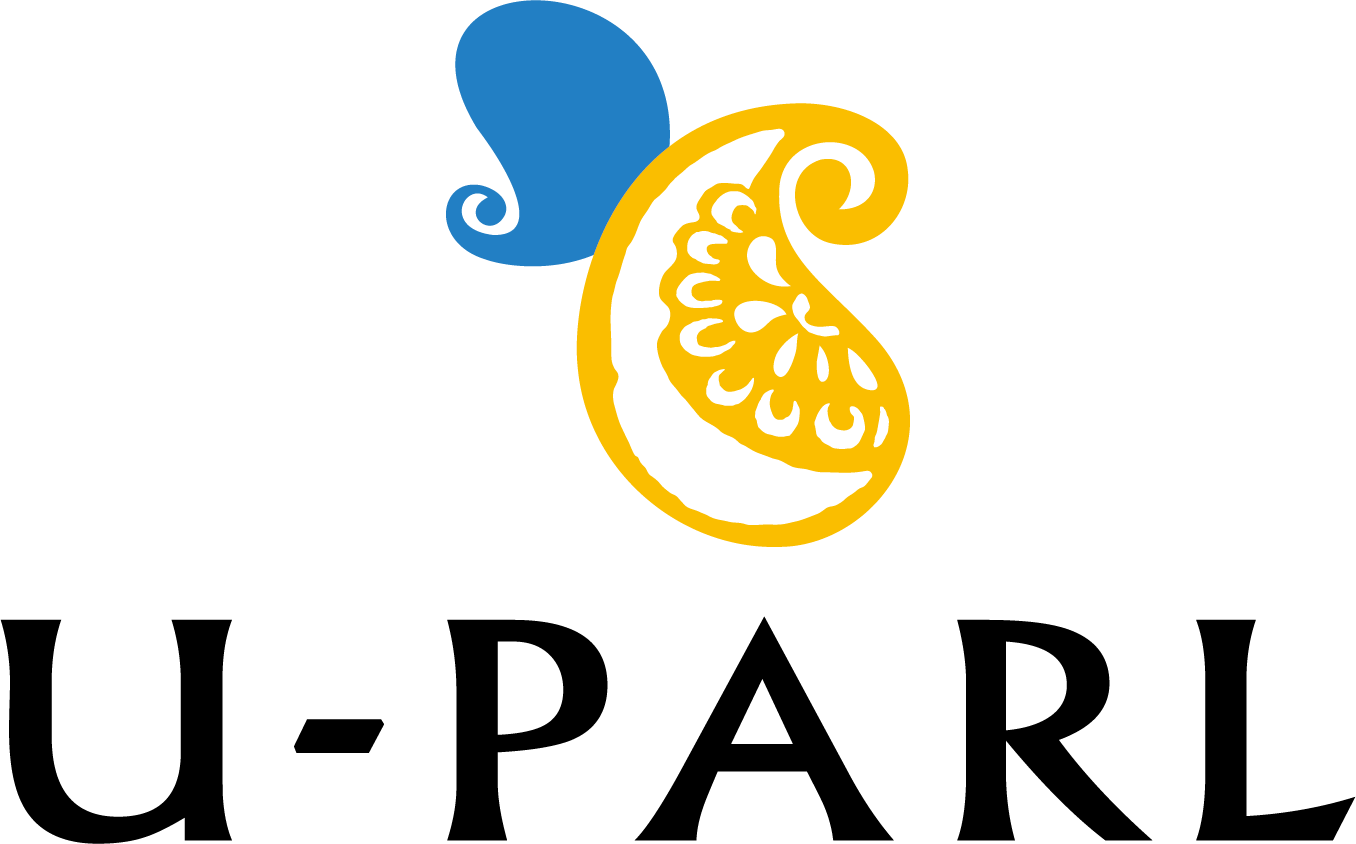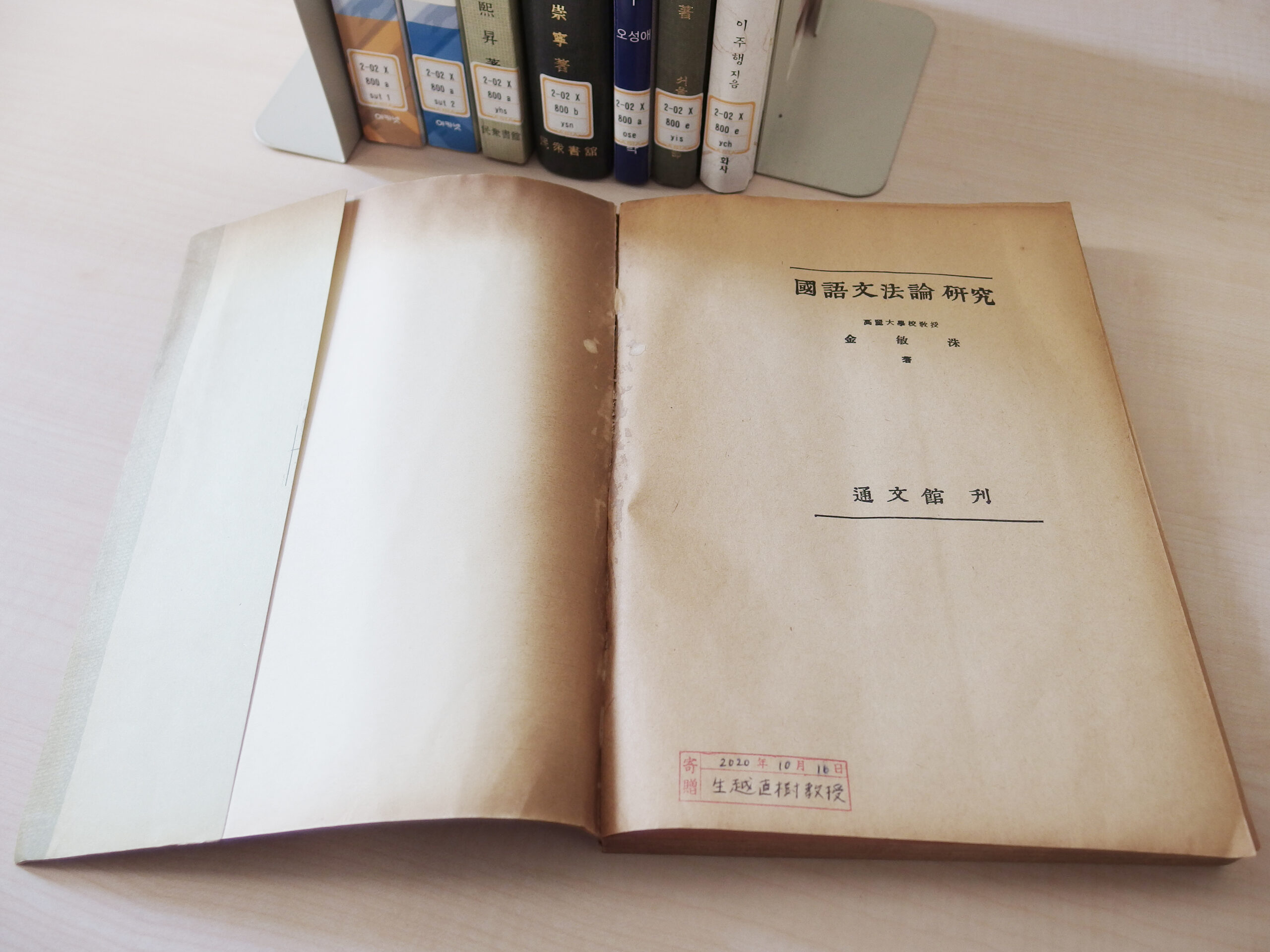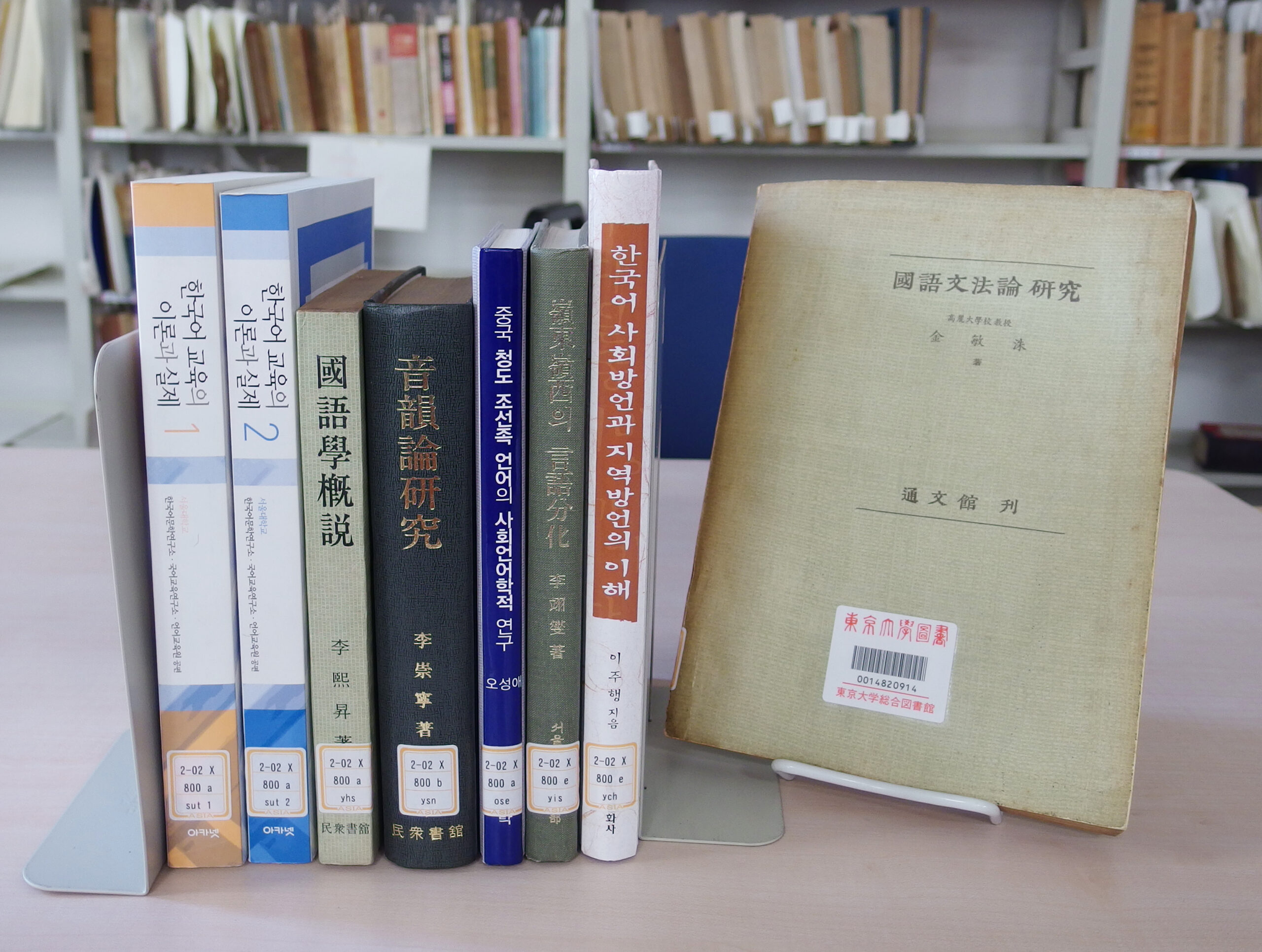This collection of materials was donated by Professor Emeritus Naoki OGOSHI who retired from the Department of Language and Information Sciences, Graduate School of Arts and Sciences, the University of Tokyo, in March 2020. The collection consists of 554 materials published in the Republic of Korea and the Democratic People’s Republic of Korea that are focused on Japanese and Korean contrastive linguistics and sociolinguistics, which were Professor Ogoshi’s academic specialization fields. All materials are in Korean.
Professor Ogoshi’s research topics are very diverse, as the professor himself acknowledges that “his research owes much to the relationships with people he happened to encounter.” Now, let us overview the professor’s career and then take a look into key features of the materials in this collection.
Attendance at and Affiliation with Osaka University of Foreign Studies and Graduate School of Osaka University
Naoki Ogoshi graduated from the Department of Korean of Osaka University of Foreign Studies in 1977 and completed his master’s program at the Graduate School for Foreign Studies of the same university in 1979 (in 2007 Osaka University of Foreign Studies was consolidated with Osaka University). As a student, Ogoshi became engaged in Korean and Japanese contrastive linguistics studies under the guidance of Professor Isao TSUKAMOTO and also participated in the compilation 朝鮮語大辞典(Chōsengo daijiten) (角川書店, 1986).
After completing the master’s program, Ogoshi transferred to the Ph.D. program in Japanese Studies at the Graduate School of Letters of Osaka University in 1979 from which he withdrew in 1982, first to take on the position of fellow at the Faculty of Letters (course in sociolinguistics for Japanese studies undergraduate program) at Osaka University, and then, in 1983, the position of part-time lecturer at Osaka University of Foreign Studies (Special Courses for Foreign Students). Ogoshi’s encounter with sociolinguistics happened when he was studying at the Graduate School of Humanities of Osaka University under late Professor Munemasa TOKUGAWA. At that time, Ogoshi taught Korean to Japan’s Korean residents (Zainichi Koreans) at a night junior high school, during which he conducted a questionnaire-based study regarding language life of Zainichi Koreans at night schools and ethnic schools. The study resulted in the following publications.
- (1982). Zainichikankoku/chosenjin no bairingarizumu ― anketo chosa no kekka kara [Bilingualism of Korean Residents in Japan: An Analysis of Questionnaire Surveys]. Machikaneyama ronso. Japanology, 16. Faculty of Letters, Osaka University.
- (1983). Zainichichosenjin-no gengo seikatsu. Gengo Seikatsu, 376. Chikuma Shobo.
Involvement in Japanese Language Education
From 1984 to 1986, Ogoshi was dispatched (as visiting lecturer) by the Japan Foundation to Korea University Department of Japanese Language and Literature, Republic of Korea; in 1986, he took on a position at the Yokohama National University College of Education (in charge of training teachers of Japanese); and in 1991, he assumed the office of Director of the Fourth Laboratory of Japanese Education Center of National Institute for Japanese Language and Linguistics. As, back then, teachers of Japanese were in urgent demand, at Korea University and Yokohama National University Ogoshi was involved both in Japanese language education and nurturing Japanese language teachers. Ogoshi shifted from the previously adopted prescriptive research approach based on modeled examples to embrace the descriptive approach, which employs natural samples from real life.
During his tenure at the National Institute for Japanese Language and Linguistics (1992‒1997), Ogoshi came to carry out research on learners of Japanese whose mother tongue was Chinese or Korean, changing his focus from Japanese education to Korean language studies. Broadly, he took up the following two academic endeavors. The first one was his research on the theoretical framework for Japanese and Korean contrastive studies, and the second one was sociolinguistic research, including participation in a multilingual comparative project on language behavior.
One of the significant results of this work was that the first collection of papers by Korean language researchers in Japan was published.
- The National Language Research Institute (Ed.). (1997). Nihongo to Chosengo [Japanese and Korean], in 2 volumes.
At University of Tokyo
After Ogoshi transferred to the Graduate School of Arts and Sciences, the University of Tokyo, he again became engaged in Japanese and Korean contrastive studies and sociolinguistics. In Japanese and Korean contrastive studies, Ogoshi made notable accomplishments in research on nominal sentences without a subject and “noun-final sentences.” In the field of sociolinguistic studies, he engaged in surveys at ethnic schools among Zainichi Koreans, particularly newcomers from South Korea, and conducted surveys on language life of the Korean Chinese at Dalian, Yanji, and Tonghua, and compared the findings with those for Zainichi Koreans. Although Ogoshi undertook his surveys among Zainichi Koreans when he was still attending the graduate school of Osaka University, these surveys can be positioned as a longitudinal study. Zainichi korian no gengoso was the first book published in Japan that dealt with the language of Zainichi Koreans.
- Jo taishogengogaku no tenbo [Preface: Perspectives of Contrastive Linguistics], Nihongo/chosengo ni okeru rentaishushoku hyogen no tsukawarekata — “Kireina hana!” taipu-no bun wo chushin-ni — [The Usage of Attributive Modifying Expressions in Japanese and Korean: a Focus on “Kireina Hana!” Sentence Classifications]. In OGOSHI Naoki (Ed.). (November 2002). Language Sciences, v.4, Contrastive Linguistics. (pp. 75–98). University of Tokyo Press.
- Zainiti korian no gengo shiyo ishiki to sono henka ― aru minzoku gakko de no anketo chosa kekka kara ―. In SANADA Shinji, OGOSHI Naoki, Yim Young Cheol (Eds.). (January 2005). Zainichi korian no gengoso. (pp. 11–52). Izumi Shoin.
- Gendai chosengo ni okeru samazama na jido/judo hyogen [Various Active and Passive Expressions in Modern Korean Language]. In OGOSHI Naoki, KIMURA Hideki, WASHIO Ryuichi (Eds.). (November 2008). Voisu no taisho kenkyu — Higashi ajia shogo kara no shiten — [Contrastive Studies of Voice: An East Asian Perspective]. (pp. 155–185). Kurosio Publishers.
Value of the Materials
As the academic career of Professor Ogoshi shows, the focus of his research can be described by the following keywords: Japanese-Korean contrastive studies, sociolinguistics, and Japanese language education. In addition to these fields, the various types of donated printed materials not only include commemorative volumes, complete works editions, and grammars of Modern and Middle Korean, but also cover a wide range of topics such as lexicology, morphology, semantics, and syntax. At the Asian Research Library, most of the materials are categorized under the class 800.
Speaking of the classification criteria for the class 800 at the Asian Research Library, materials related to other regions are further subdivided based on the language they are written in, but materials related to East Asia in Korean and Chinese are classified by adding a symbol representing the lower subject classification. The subject categories are almost the same for both languages, except for the category “800 x Minority languages in China” additionally established in the Chinese section of the catalog.
【Korea】
800 a Korean language general
800 b Korean phonology
800 c Hangeul, style of writing, orthography
800 d Korean lexicology, grammar, semasiology, communication
800 e Korean linguistic geography, dialects, linguistic contact
【China】
800 a Chinese language general
800 b Chinese phonology
800 c Chinese characters, style of writing, orthography
800 d Chinese lexicology, grammar, semasiology, communication
800 e Chinese linguistic geography, dialects, linguistic contact
800 x Minority languages in China
Let us take a look at some of the donated materials classified under the class 800 that are particularly worthy of special mention.
[800]
This category comprises materials that are not dedicated to a particular language, facsimiles and annotated translations, handbooks and almanacs, etc.
- 李明奎 (Comp.). (1984). 『(註解)中世國語選』. 東星社.
- 한글학회 (Ed.). (1997). 『국어학 자료은행 편람1-4』. 한글학회.
[800 a Korean language general]
This category comprises, in addition to commemorative volumes and complete works editions, materials on sociolinguistics, education theory, etc.
- 유목상. (1986). 『國語學新硏究 : 若泉金敏洙敎授華甲紀念』.탑출판사.
- 基谷 姜信沆先生 華甲紀念論文集刊行委員會 編『國語學論文集 : 姜信沆敎授回甲紀念』 (태학사, 1990)
- The Complete Works on Korean Linguistics series issued by the Social Sciences Press of the Democratic People’s Republic of Korea (some volumes missing)
[800 b Korean phonology]
- 李基文. (1972).『國語音韻史硏究』. 한국문화연구소.
[800 c Hangeul, style of writing, orthography]
This category comprises materials dealing with orthography and national hangul-only movement, as well as the alphabet itself.
- 고영근. (1998). 『한국어문운동과 근대화』. 탑출판사.
- 사회과학원언어학연구소. (1972).『조선말규범집해설(朝鮮語規範集解説)』. 학우서방.
[800 d Korean lexicology, grammar, semasiology, communication]
Many of the materials in this category were published after the 1970s, but some of them date to earlier years, and there are even really rare ones including the following volumes:
- Kim Min Su. (1960). A Study of Korean Grammar. Thongmungwan. (in Korean)
- 李崇寧. (1961). 『국어조어론공(国語造語論攷)』. 乙酉文化社.
[Kim Min Su 1960] presents a collection of academic papers published by Korea University Professor Emeritus Kim Min Su (1926–2018) from 1948 to 1960. [李崇寧 1961] is a monograph by Dr. Lee Sung Nyong (1908–1994). Together with [Kim Min Su 1960], this monograph sheds light on the situation in Korean language studies after the end of Japanese imperial rule. These books are not only important from the viewpoint of understanding the academic research history, but they also may become future primary sources for studying Korean linguistics history. Moreover, in addition to grammars of Modern and Middle Korean, the materials also cover a wide range of topics such as lexicology, morphology, semantics, and syntax.
[800 e Korean linguistic geography, dialects, linguistic contact]
- 李翊燮. (1981). 『嶺東嶺南의 言語分化』. 서울大學校出版部.
- 국립국어원 (Ed.). (2010). 『(2010년) 중국 집단 이주 한민족의 지역어 조사 보고서 : 경북 경주 지역어』. 국립국어원.
Materials other than those categorized under the class 800 include publications of academic societies and research institutions, beginning with 韓国国語教育研究会 (Ed.). (1988). 『한국 국어 교육 연구회 30년사』. 아세아문화사. UTokyo OPAC (u-tokyo.ac.jp) On the whole, regardless of their volume, these materials make for highly valuable rare resources that are difficult to obtain today.
<References>
Prof. Naoki OGOSHI’s Last Lecture Organization Committee (Ed.). (February 2020). Ogoshi naoki sensei saishu kogi kinen, watashi-no kenkyu to deatta katagata
東京大学教養学部教養学部報「駒場をあとに「なんで,私が東大に」」January 7, 2020.
https://www.c.u-tokyo.ac.jp/info/about/booklet-gazette/bulletin/615/open/615-01-1.html
Introduction prepared by SHIBUYA Aki(Ass. Professor at Graduate School of Humanities and Sociology, former U-PARL Project Academic Support Staff)
February 29, 2024



